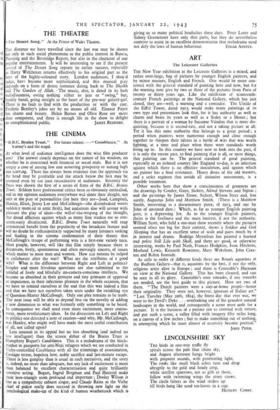The Leicester Galleries
ART
THE New Year exhibition at the Leicester Galleries is a mixed, and rather over-large, bag of pictures by younger English painters, and by minor masters, English and French. One- would be more con- tented with the general standard of painting here and now, but for the warning note give by two or three of the pictures from Paris of twenty or thirty years ago. Like the exhibition of nineteenth- century French paintings at the National Gallery, which has just dosed, they are—well, a warning and a reminder. The Utrillo of the Eiffel Tower, dated 1913, would make many paintings of its own type and pretentions look thin, for it has authority as well as charm and bears its years as well as a Sisley or a Monet ; but there is a portrait of a woman by Suzanne Valadon that is more dis- quieting, because it is second-rate, and not a taking picture at all. - Yet it has this same authority that belongs to a great period ; a period when painters were numerous enough and close enough together to sharpen their talents in a battle of wits that was worth fighting, at a time and place when there were standards worth living up to. In this country we have now to look into the past, if it is only the recent past, to find painting that is all, or most things, that painting can be. The general standard of good painting, especially m an isolated country like England to-day, is an infection against which there is no effective inoculation, and against which no painter has a final resistance. Heavy doses of the old masters, and a strict regimen that avoids all imitative movements, is a possible treatment.
Other works here that show a consciousness of greatness are the drawings by Conder, Guys, Sickert, Alfred Stevens and Signac ; and the paintings by James Ensor, Sickert, Wilson Steer and, less surely, Augustus John and Matthew Smith. (There is a Matthew Smith, interesting as a documentary piece, of 1913, and one by John of unstated date.) Which, as far as younger English painting goes, is a depressing list. As to the younger English painters, theirs is the liveliness and the main interest, if not the authority. William Scott, who held a one-man show recently where the pictures seemed often too big for their content, shows a Soldier and Girl Sleeping that has an excellent sense of scale and gains much by it in interest and drama. Rodrigo Moynihan has painted a learned and polite Still Life with Shell, and there are good, or otherwise interesting, works by Paul Nash, Frances Hodgkins, Ivon Hitchens, Morland Lewis, Kenneth Rowntree, Mary Wykeham, John Crax- ton and Robin Ironside.
As calls to order of different kinds there are Roualt aquatints at the Redfern Gallery—that is, aquatints by the best, if not the only, religious artist alive in Europe ; and there is Constable's Haywain on view at the National Gallery. This has been cleaned, and can be seen in all its glory. Constable's own remarks, if any remarks are needed, are the best guide to this picture. Here are two of them. "The Dutch painters were a stay-at-home people—hence their originality. They were not, however, ignorant of Italian art." " Last Tuesday (May 29th, 1824), the finest day that ever was, we went to the Devil's Dyke . . . overlooking one of the grandest natural landscapes in the world, and consequently a scene most unfit for a picture. It is the business of a painter not to contend with nature, and put such a scene, a valley filled with imagery fifty miles long, on a canvas of a few inches ; but to make something out of nothing, in attempting which he must almost of necessity become poetical."
JOHN PIPER.


























 Previous page
Previous page